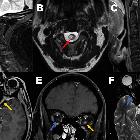Cogan's syndrome

Cogan syndrome is a rare vasculitis of young adults that is primarily characterized by:
- inflammatory eye disease (classically interstitial keratitis)
- audiovestibular dysfunction (similar to Meniere disease)
Epidemiology
Cogan syndrome is rare and can occur in people of any age and race. It most frequently presents in young adults in their late 20s or early 30s.
Clinical presentation
Typical Cogan syndrome manifests with interstitial keratitis and audiovestibular symptoms similar to Meniere disease (tinnitus, vertigo, and hearing loss). Auditory symptoms can precede or follow eye disease, usually within two years.
Atypical Cogan syndrome presents with other types of inflammatory eye disease (such as uveitis, scleritis, and optic neuritis), audiovestibular symptoms that may not resemble Meniere disease, and longer intervals between the onset of ocular and vestibuloauditory disease. However, this distinction may not carry prognostic significance.
A substantial minority of patients also develop systemic vasculitis . Common systemic symptoms include headache, arthralgia/arthritis, myalgia, fever, and fatigue. The most characteristic cardiovascular manifestation is aortitis .
Pathology
Etiology
An autoimmune reaction to the eyes and audiovestibular structures has been postulated, possibly triggered by an upper respiratory tract infection.
Microscopic appearance
Vestibulocochlear structures demonstrate endolymphatic hydrops with the perilymphatic compartments filled with loose fibrous tissue.
Radiographic features
CT
- calcific or soft tissue attenuation obliterating the intralabyrinthine fluid spaces
MRI
- T1: high signal in the membranous labyrinth of the inner ear
- T1 C+ (Gd): enhancement of the membranous labyrinth
- T2: soft tissue obliteration or narrowing of the intralabyrinthine fluid spaces
Treatment and prognosis
Treatment consists of immunosuppression, starting with glucocorticoids and adding other immunosuppressive agents depending on the severity of the condition.
The course of the disease varies significantly from patient to patient. In some patients, there is an initial flare, which may last several weeks to months. Following this, there may be a slowly progressive course in some patients while others have a course of complete remission with intermittent episodes of disease activity.
Life-threatening aortic insufficiency develops in 10% of reported cases. Blindness occurs in less than 5% of patients. Deafness is a frequent and debilitating outcome occurring in up to 54% of patients.
History and etymology
It was initially described by David Glendenning Cogan (1908-1993), American ophthalmologist, in 1945.
Differential diagnosis
The differential consists of inflammatory causes of both eye and inner ear disease:
- sarcoidosis
- syphilis
- Whipple disease
- rheumatoid arthritis
- Sjögren syndrome
- systemic lupus erythematosus
- systemic vasculitides, such as polyarteritis nodosa and granulomatosis with polyangiitis
- relapsing polychondritis
- Behcet syndrome
- Vogt-Koyanagi-Harada syndrome
- inflammatory bowel disease
The differential for systemic vasculitis affecting large vessels is primarily Takayasu arteritis.
Practical points
- prompt recognition and exclusion of other diseases with similar presentation
- prompt treatment with glucocorticoids and secondary-line immunosuppressive therapy if not responsive
- awareness of the development of vasculitis, and particularly aortitis, with associated complications
Siehe auch:
und weiter:

 Assoziationen und Differentialdiagnosen zu Cogan-Syndrom:
Assoziationen und Differentialdiagnosen zu Cogan-Syndrom:


